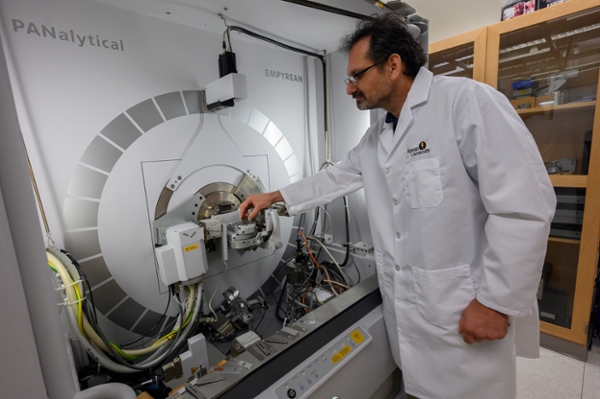Rowan researchers discover unique properties of advanced materials
Rowan researchers discover unique properties of advanced materials

A new study, recently published in the top peer-reviewed research journal Advanced Materials, examines the unique properties of a specific class of materials. The material—lead indium manganate-lead magnesium niobate-lead titanate (PIMPMNPT for short)—is part of a subset of materials called piezoelectrics, said Samuel Lofland, Ph.D., a professor of physics in the College of Science and Mathematics, associate director of Advanced Materials & Manufacturing Institute, and the senior author of the study.
“When you apply an electric voltage to a piezoelectric, it changes size; it becomes bigger or smaller,” said Lofland, who has been studying piezoelectrics for several years. “Then if you reverse the voltage, the opposite happens: it becomes smaller or bigger.”
This process can be repeated millions of times, unlike most any other material, Lofland said.
“It’s unparalleled,” Lofland said. “Many materials like glass simply shatter. Even materials that don’t, like metals, will break if you bend them a million times. They just fatigue.”
The piezoelectric material that Lofland and an interdisciplinary team of international scientists examined is made up of small crystals, each transparent, but like finely ground powder, they make the material opaque. When electric voltage or pressure is applied to the material, all the small crystals form one big crystal and light can then travel through it. It’s like glass that can be reversibly transformed between being a powder and a solid.
Due to its unusual properties, this material can be used in sonar devices and other types of detectors and sensors.
“Suppose you wanted to sense whether an object was under pressure, for instance,” Lofland said. “Most of the time, you have to have some sort of electrical connection to the sensor. In this case, what would happen is you would see that the material would go from opaque to transparent. You could use it as a sensor where you don't need to have any electrical connections.”
The study’s many collaborators included scientists from the U.S. Naval Research Laboratory and national laboratories in the U.K., France, and Australia. Two Rowan undergraduate physics students—Kyril Kavetsky, now pursuing his Ph.D. in materials science at the University of Pennsylvania, and Chad Newkirk, who now works for an optics company in North Jersey—analyzed the video data. As senior author, Lofland was chiefly responsible for helping to distill the collaboration’s many findings into a coherent story.
Offering students the opportunity to study relevant topics within their field of study is one of the more meaningful aspects of the investigation, Lofland said.
“It’s important to have research be more than something that sits in an ivory tower,” Lofland said.